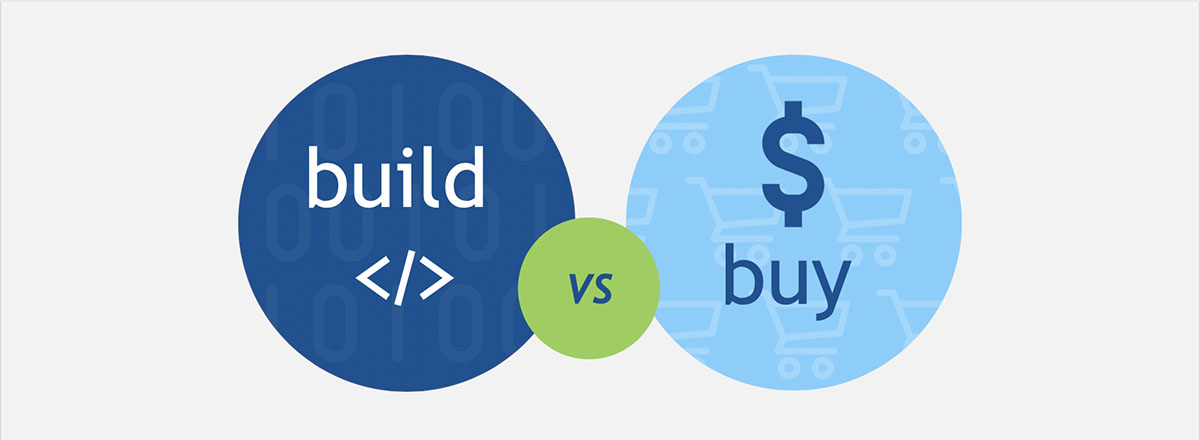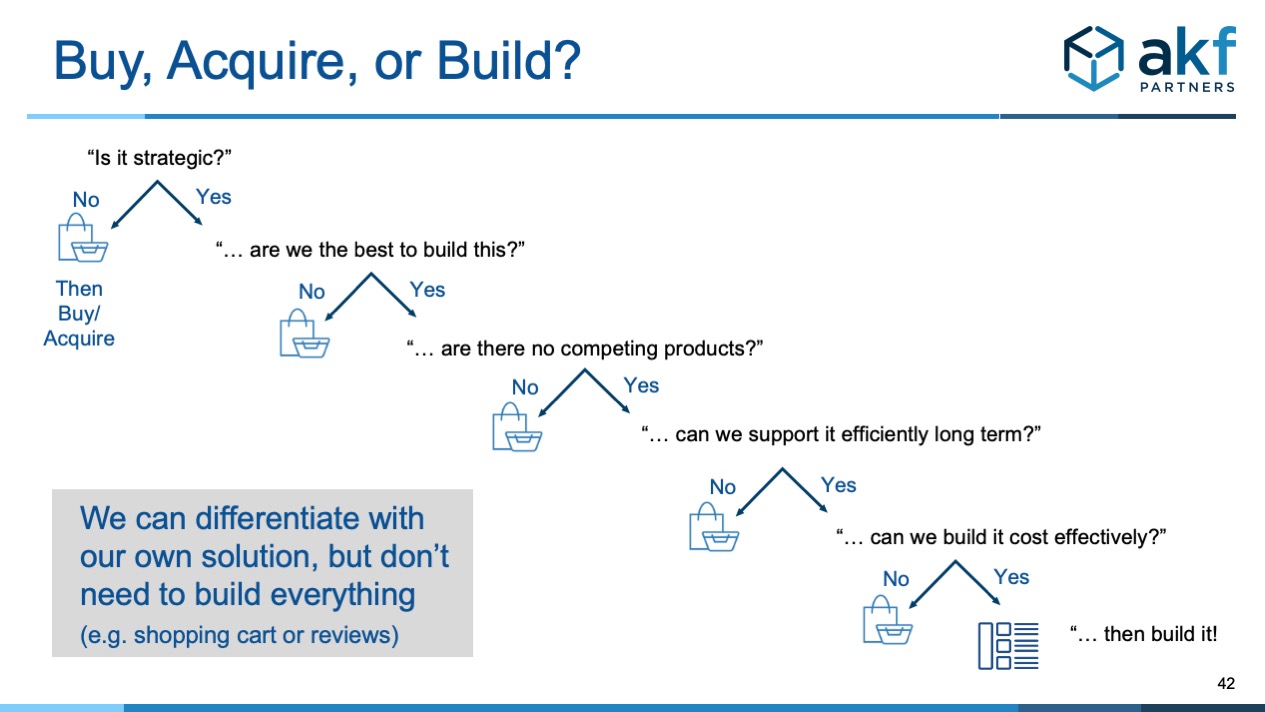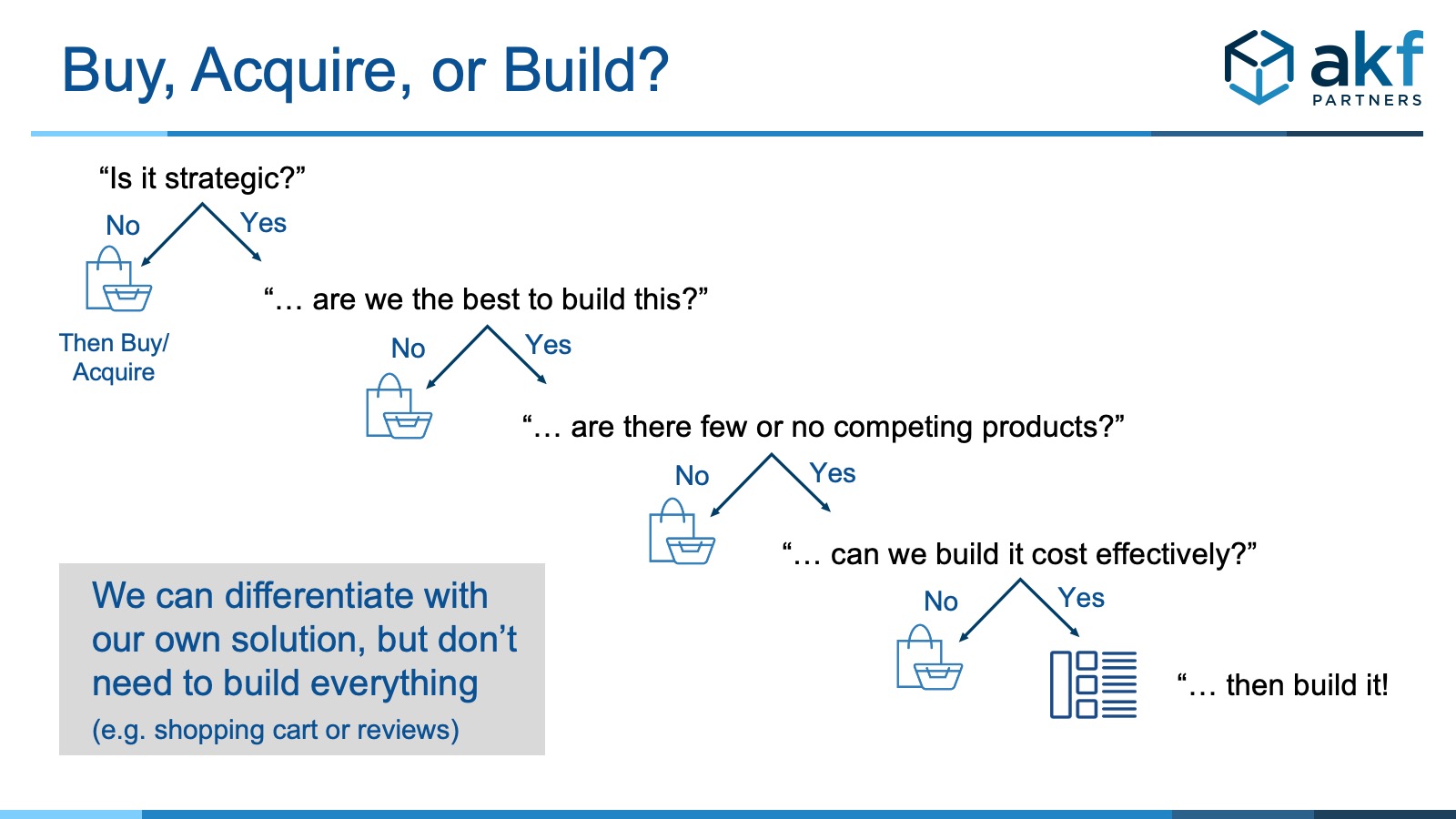
In many of our technical due diligence engagements, it is common to find that companies are building tools with considerable development effort (and ongoing maintenance) for something that is not part of their core strength and thus providing a competitive advantage. What criteria does your organization us in deciding when to build vs. buy?
If you perform a simple web search for “build vs. buy” you will find hundreds of articles, process flows, and decision trees on when to build and when to buy. Many of these are cost-centric decisions including discounted cash flows for maintenance of internal development and others are focused on strategy. Some of the articles blend the two.

We have many examples from our customers developing load balancing software, building their own databases, etc. In nearly every case, a significant percentage of the engineering team (and engineering cost) go into a solution that:
- Does not offer long term competitive differentiation
- Costs more than purchasing an existing product
- Steals focus away from the engineering team
- Is not aligned with the skills or business level outcomes of the team
If You Can't Beat Them - Join Them(or buy, rent, or license from them)
Here is a simple set of questions that we often ask our customers to help them with the build v. buy decision:
1. DOES THIS “THING” (PRODUCT / ARCHITECTURAL COMPONENT / FUNCTION) CREATE STRATEGIC DIFFERENTIATION IN OUR BUSINESS
Shiny object distraction is a very real thing we observe regularly. Companies start - innocently enough - building a custom tool in a pinch to get them by, but never go back and reassess the decision. Over time the solution snowballs and consumes more and more resources that should be focused on innovating strategic differentiation.
- We have yet to hear a tech exec say "we just have too many developers, we aren't sure what to do with them."
- More often than not "resource constraints" is mentioned within the first few hours of our engagements.
- If building instead of buying is going to distract from focusing efforts on the next "big thing" – then 99% of the time you should just stop here and attempt to find a packaged product, open-source solution, or outsourcing vendor to build what you need.
If after reviewing these points, if the answer is “Yes, it will provide a strategic differentiation,” then proceed to question 2.
2. ARE WE THE BEST COMPANY TO BUILD THIS “THING”?
This question helps inform whether you can effectively build it and achieve the value you need. This is a “core v. context” question; it asks both whether your business model supports building the item in question and also if you have the appropriate skills to build it better than anyone else.
For instance, if you are a social networking site, you probably don’t have any business building relational databases for your own use. Go to question number (3) if you can answer “Yes” to this question and stop here and find an outside solution if the answer is “No”.
And please, don’t fool yourself – if you answer “Yes” because you believe you have the smartest people in the world (and you may), do you really need to dilute their efforts by focusing on more than just the things that will guarantee your success?

3. ARE THERE FEW OR NO COMPETING PRODUCTS TO THIS “THING” THAT YOU WANT TO CREATE?
We know the question is awkwardly worded – but the intent is to be able to exit these four questions by answering “yes” everywhere in order to get to a “build” decision.
- If there are many providers of the “thing” to be created, it is a potential indication that the space might become a commodity.
- Commodity products differ little in feature sets over time and ultimately compete on price which in turn also lowers over time.
- A “build” decision today will look bad tomorrow as features converge and pricing declines.
If you answer “Yes” (i.e. “Yes, there are few or no competing products”), proceed to question (4).
4. CAN WE BUILD THIS “THING” COST EFFECTIVELY?
- Is it cheaper to build than buy when considering the total lifecycle (implementation through end-of-life) of the “thing” in question? Many companies use cost as a justification, but all too often they miss the key points of how much it costs to maintain a proprietary “thing”, “widget”, “function”, etc
- If your business REALLY grows and is extremely successful, do you want to be continuing to support internally-developed monitoring and logging solutions, mobile architecture, payments, etc. through the life of your product?
Don’t fool yourself into answering this affirmatively just because you want to work on something "neat." Your job is to create shareholder value – not work on “neat things” – unless your “neat thing” creates shareholder value.
There are many more complex questions that can be asked and may justify the building rather than purchasing of your “thing,” but we feel these four questions are sufficient for most cases.
A “build” decision is indicated when the answers to all 4 questions are “Yes.”
We suggest seriously considering buying or outsourcing (with appropriate contractual protection when intellectual property is a concern) anytime you answer “No” to any question above.
CONCLUSION
While startups and small companies roll their own tools early on to get product out the door, as they grow, the timeline of planning (and related costs) needs to increase from the next sprint to a longer-term annual and multi-year strategy. That, plus growth, tips the scale to buy instead of build. The more internal products produced and supported, the more tech debt is required and distracts medium-to-large organizations from competing against the next startup.
While building custom tools and products seems to make sense in the immediate term, looking at the long-term strategy and desired outcome of your organization needs to be fully-weighted in the decision process. Distraction from focus is the number one harm we have seen many times with our clients as they fall behind the competition and burn sprint cycles on maintaining products that don't move the needle with their customers. The crippling cost of distractions is what causes successful companies from losing their competitive advantage as well as slipping into oblivion.
Like the ugly couch your auntie gave you for your first apartment, it can often be difficult to assess what makes sense without an outside opinion. Contact us, we can help!